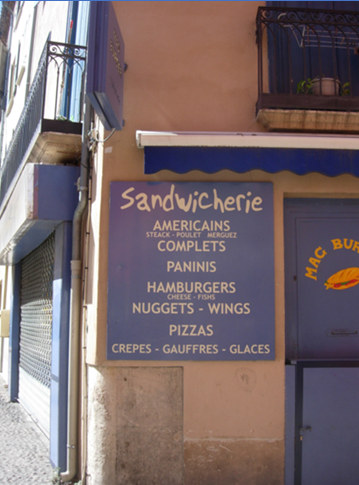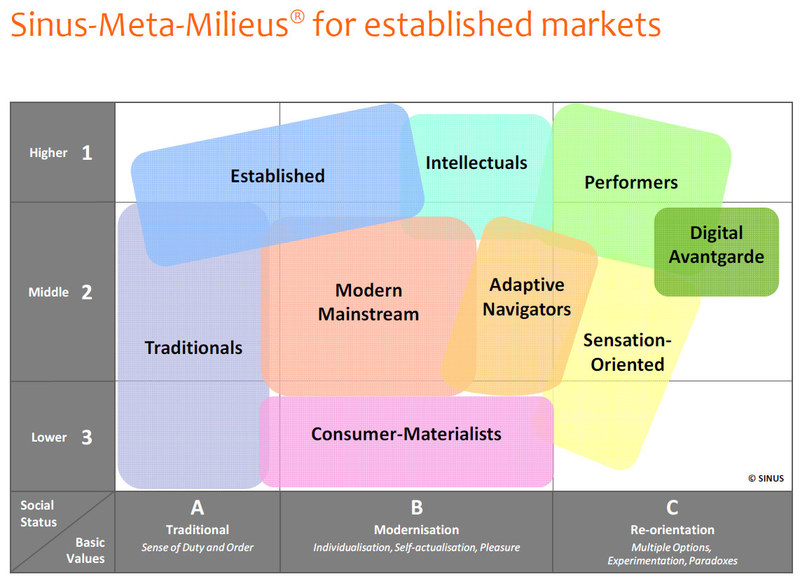We are experiencing an accelerated process of diversification in most western societies. These are mostly migration driven, and involve more and more identities, differences in lifestyles and family formations. These processes are currently inducing cultural, economic, and developmental changes. The photograph below serves as an example of cultural changes such as the growing variety of food and dishes, changing eating habits, cultural mixing as well as changes in the use of language. It shows a so-called ‘sandwicherie’ in Barcelona.

Photograph by Adelheid Iken
A sandwich is commonly understood to be two pieces of bread with food in between, which is eaten by hand. It is considered to have its origin in the 18th century in Great Britain with John Montagu, the 4th Earl of Sandwich as its namesake. In the 19th century its popularity as a lunch option increased in Spain and England when the rise of industrial society and the working class made it necessary to eat while away from home. In Spain, where the word Sandwich is borrowed from the English language, it commonly refers to food made from English soft sandwich bread. But it appears as if a sandwicherie as seen on this picture is used in a much wider sense, encompassing different forms of snacks and luncheons such as Americains, Hamburgers and crepes. Sandwicherie might be translated as 'sandwich bar' or 'sandwich shop'.
The next example is insightful because it deals with the fairly commonly held stereotype in Germany that many, if not most, migrants of Turkish or Moroccan descent would agree with the statement that women should not work outside the home while their children are still young. Again, the figures tell us otherwise, showing that responses differ across countries and that education is one of the strongest impact variables on gender role attitudes.

Source: Cul, Maurice; Schneider, Jens & Frans Lelie (2013, p. 21). Superdiversity, A new perspective on integration. Amsterdam: VU University.
Infographic by Annelies Vlasblom / Zeppa Creative Studio (Amsterdam), reprinted with permission. Available at elitesproject.eu. Accessed 11 June 2025. Not CC licensed.
The previous example shows the findings of the Sinus Institute, a renowned body that studies people’s changing values and everyday lifeworlds. The illustration shows the so-called 'Sinus Meta-Milieus' or the day to day realities in German society. It highlights in particular the heterogeneous nature of modern values and lifestyles and the fact that within a country we can differentiate between many different milieus or groups, which all share a similar outlook on life. For example, the 'performers' tend to dispose of a global economic mindset, are efficiency-oriented and perceive themselves as avant-garde with regard to consumption and style. Modern mainstreamers on the other hand are people ready to adapt and aim to achieve a secure and harmonious life. They tend to be achievement-oriented and strive to become established in professional as well as social circles.
So on the one hand a variety of values, lifestyles as well as life strategies can be found within a country, and on the other transnational similarities can be found. In other words, a performer is likely to find people in other countries with a similar mindset.

Source: SINUS Markt- und Sozialforschung GmbH (2006). Information on Sinus-Milieus 2015, pp. 23. https://www.sinus-institut.de/fileadmin/user_data/sinus-institut/Downloadcenter/20150805/2015-01-15_Information_on_Sinus-Milieus_English_version.pdf. Reprinted with permission. Accessed 5 November 2020. Not CC licensed.
What we learn from these examples is that many societies are experiencing an unprecedented level of diversity within them, while these are also triggered by outside influences. This may precipitate challenges such as communication barriers and interpersonal conflict due to bias and prejudice, but at the same time it can bring many opportunities such as novel experiences, skills and perspectives. One of the safest predictions we can make about the next generation is that it will be more diverse than it is today.
The term Super-diversity, coined by Steven Vertovec, underlines this development and emphasises that we are currently experiencing a level of complexity that surpasses anything previously experienced. Over the past decade, far more people have moved from one place to another than in the preceding decades. Additionally, an increasing number of individuals have been raised in one or more cultural contexts other than that of their parents, and ever more children are born to couples from differing cultural backgrounds while more and more people spend a large part of their lives outside their home country. All these phenomena are tied up with a vast increase in levels of immigration and diversity.
In addition to the diversity induced by migration and immigration, it is important to acknowledge other variables that influence the complexity of social relations and behavioural patterns. New forms of diversity and heterogeneity have gone hand in hand with more encompassing identities, for example. A very recent example of this is the acknowledgement of a third gender in societies, which is now officially recognised in a number of countries.
People today are also strongly influenced by social media, with internet exchanges influencing their habits, preferences and behaviour. The tremendous international success of movies made in India with high drama and traditional costumes commonly referred to as ‘Bollywood’ serves as an example here. And there are other relevant variables that contribute to emerging, acquired and inherent diversities, but which have received less attention in the past such as gender, social status, profession and power structures to name just a few.
It can therefore be argued that although Vertovec focuses on migration patterns, the concept of Super-diversity should encompass a whole range of factors and we should acknowledge that it concerns everyone, including people who live where they were born, but are increasingly exposed to cultural others in their workplace or social environment. Super-diversity may therefore rather be seen as a lens through which intercultural encounters can be analysed.
To conclude, we can say that the speed, scale and spread of diversity has reached unprecedented levels and that this development is challenging our understanding of intercultural interactions and intercultural communication.
Task: Changing eating habits
Changing eating habits are easier to reconstruct and reflect than changed behaviour.
Go on the internet and search for the following:
- the origins of pizza
- the dissemination of pizza in your home country
How far do you think the original recipe of pizza has been amended to meet local demands?
Note down the answers in your learning journal.
Having completed this task, click on the following link to view a possible answer.
Show / hide sample answer
This is Olesia's answer:
The history of pizza begins in antiquity, when various ancient cultures produced basic flatbreads with several toppings. Modern pizza evolved from similar flatbread dishes in Naples, Italy, in the 18th or early 19th century. Pizza was mainly eaten in Italy and by emigrants from there. This changed after World War II when Allied troops stationed in Italy came to enjoy pizza along with other Italian foods (information taken from Wikipedia).
In Russia, where I come from, pizza is a very popular dish. People cook it themselves, buy it as a semi-product, order in restaurants, etc. Many restaurants have developed their own recipes for pizzas with some special toppings. People enjoy eating pizza, but still it is considered to be fast food and mainly goes with Coca-Cola. Pizza is popular for parties or other festivals. It is mostly preferred by young people.
I think that the original recipe has been drastically amended – first of all because nowadays we have more spices, new cooking technologies and our tastes have changed. Moreover, people tend to experiment more and have sophisticated preferences. Finally, each place on the Earth has its own cooking traditions, so even a globally accepted dish should be in accord with the local conditions.